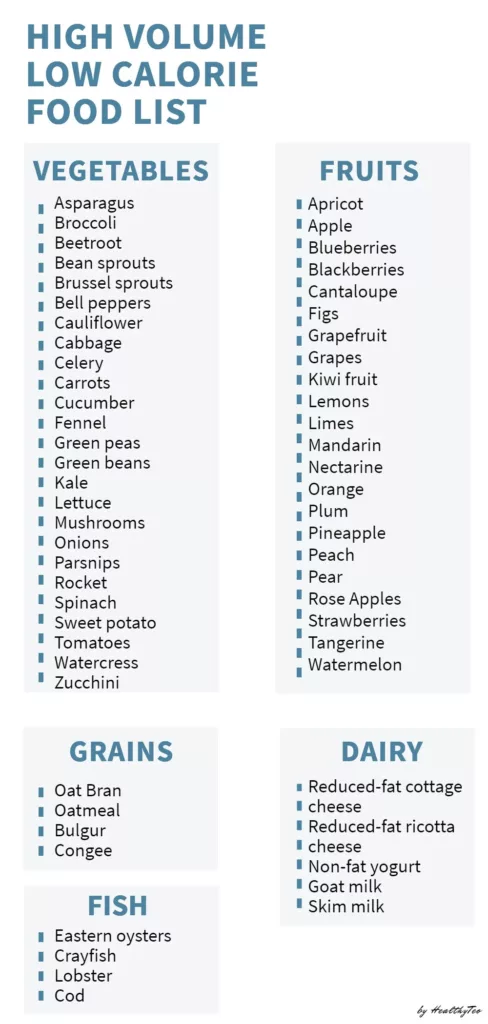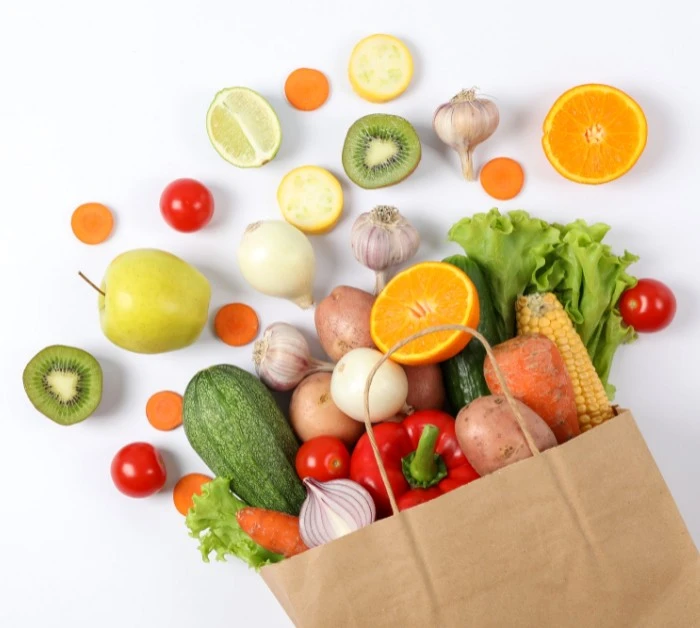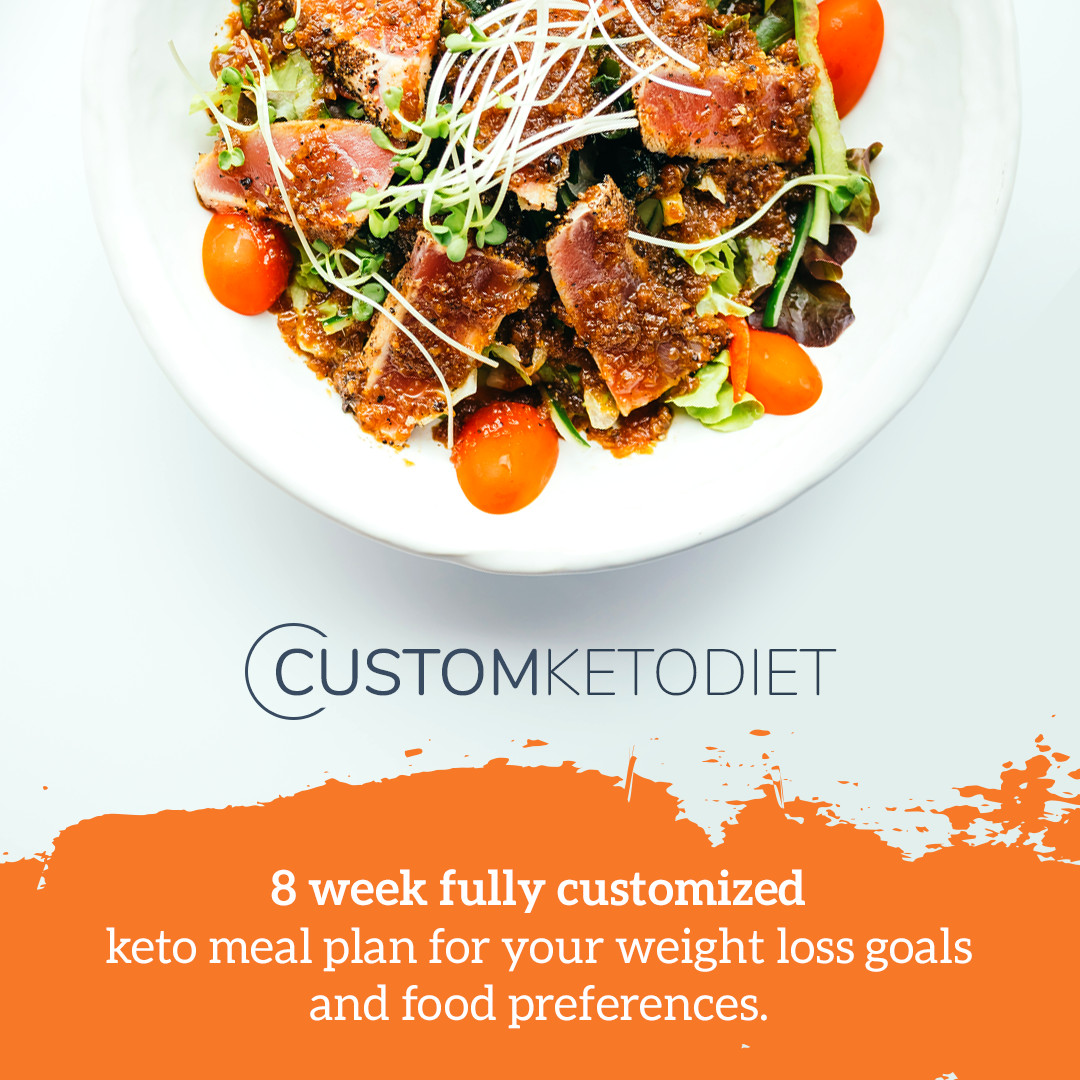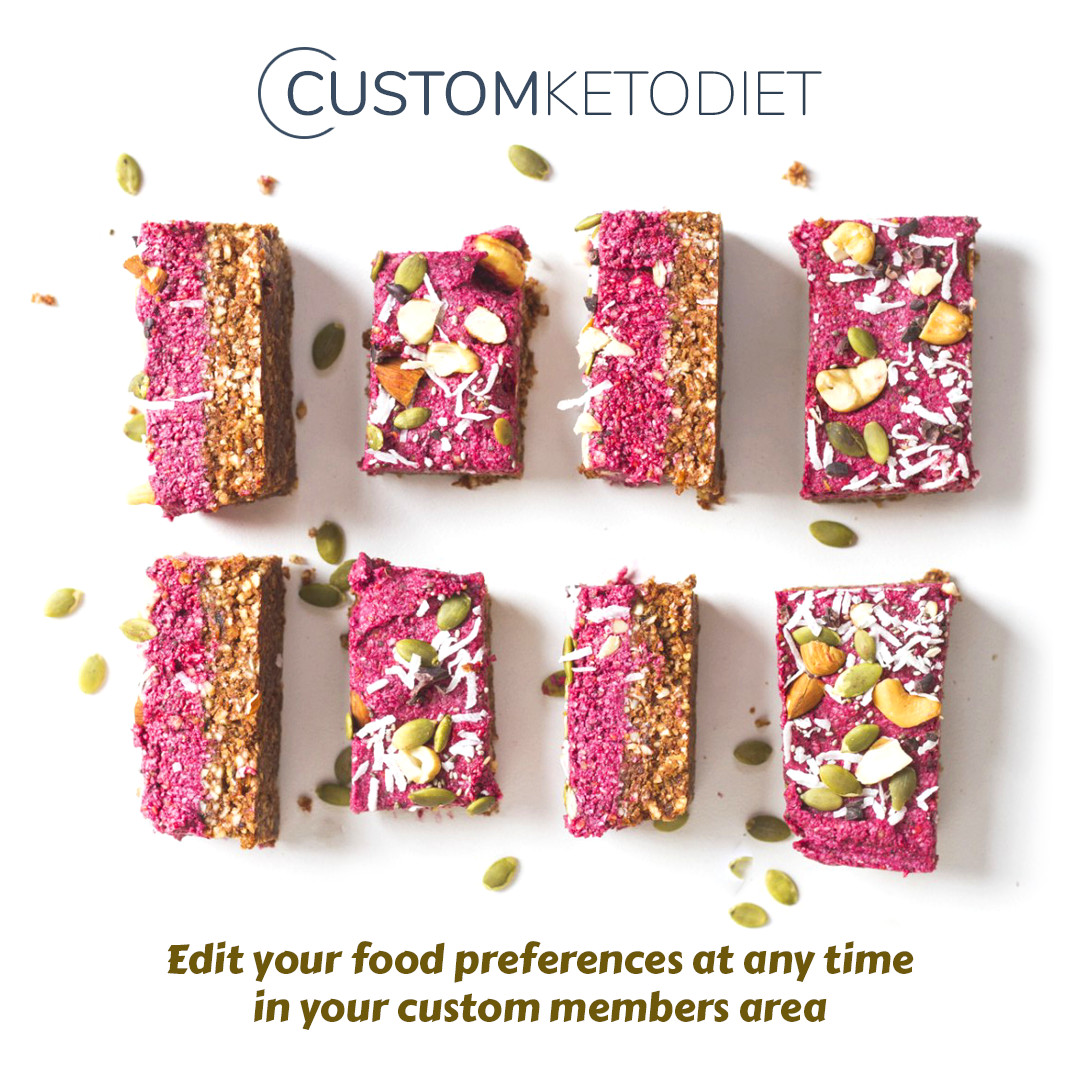High volume low-calorie foods
High-volume foods with low calories will help you eat more, never feel hungry, and can also help if your goal is weight loss.
Most of these high-volume foods contain water that will help you stay hydrated. They are not just low in calories, but these foods are also nutrient-dense.
You will get lots of vitamins and minerals by including high-volume, low-calorie foods in your healthy diet. Furthermore, you’ll get a lot of fiber which is essential for good digestive health.
What are high volume low-calorie foods?
High-volume low-calorie foods are foods that contain more water and have lower energy density. Energy density is defined as the amount of energy or calories in a particular weight of food and is generally presented as the number of calories in a gram (kcal/g).
Foods with a lower energy density provide fewer calories per gram than foods with a higher energy density.
High-energy density foods have a concentrated amount of calories per bite ( think chocolate chips).
Lower-energy density, high-volume foods have fewer calories per gram than their high-energy density counterparts ( think fruits and vegetables).
High-volume low-calorie foods are the base of the Volumetrics Diet. According to many people, Volumetrics eating is one of the best ways to lose weight. On this diet you will feel full, never hungry and you can eat many foods.
Many of the foods presented here are part of the Volumetrics Diet.
List of high volume foods with low calories
Vegetables
Vegetables are foods with a low-calorie density and are very filling due to the high amount of water in their composition. While nearly every vegetable is low in calories some are lower than others.
To keep vegetables low in calories and retain the most nutrients, it is best to eat them raw or steamed.
List of low-calorie vegetables:
Cucumber
Water content: 96%
Cucumbers are one of the most hydrating vegetables. They are low in calories but high in very important vitamins and minerals such as vitamin C, vitamin K, magnesium, potassium, manganese.
They have high water content. Cucumbers are made up of about 96% water and have only 12 calories per 100 g.
To maximize their nutrient content cucumbers should be eaten unpeeled. Peeling them reduces the amount of fiber as well as certain vitamins and minerals.
Sour pickled cucumbers
Water content: 94%
Pickled cucumbers are fermented vegetables that are especially useful in soothing an upset stomach. Sour pickled cucumbers are high in volume (94.08% water) and have only 11 calories per 100 g.
Arugula
Water content: 90%
Arugula leaves, also known as rocket or roquette, is a lesser-known cruciferous vegetable of the same family which includes kale, broccoli, and Brussel sprouts.
According to the United States Department for Agriculture (USDA), a cup of arugula weighing about 20 grams contains 5 calories or 100 g of arugula contains only 25 calories.
Lettuce
Water content: 96%
Lettuce is full of important nutrients such as fiber, potassium, manganese, and vitamins A and C. This nutritious vegetable comes in many varieties.
Although romaine and iceberg are the most common types many other varieties exist such as crisphead lettuce, butterhead lettuce, leaf lettuce, stem lettuce. Each of them has a unique flavor and nutritional properties.
Mostly used romaine lettuce has about 17 calories per 100 g serving.
Watercress
Water content: 95%
Sometimes overlooked leafy green that packs a powerful nutrient punch. Watercress is also part of the family of vegetables which include kale, cabbage, and Brussel sprouts.
One cup (34 grams) of watercress contains about 4 calories or 11 calories in a 100 g serving. It is especially rich in vitamin K. Just one cup of watercress provides over 100% of the RDI for vitamin K. Important vitamin necessary for blood clotting and healthy bones.
Celery
Water content: 95%
Celery is another high-volume vegetable since 95.43% of its composition is water. Celery has only 14 calories per 100 g.
Its crunchy stalks make the vegetable a popular low-calorie snack. Celery provides a decent amount of vitamin B and C, potassium, calcium, and phosphorus.
Cabbage
Water content: 92%
Cabbage has an outstanding nutrient profile and is especially high in Vitamin K and C. It comes in a variety of shapes and colors, including red, purple, white, and green, and its leaves can be either crinkled or smooth.
There are many different varieties of cabbage. Here in this list of high volume low-calorie vegetables, we’ll mention the Chinese Cabbage also known as Pak-Choi or Bok-Choy. It is high in volume (95.32% water) and has just 13 calories per 100 g.
White Mushrooms
Mushrooms are a type of fungus with a sponge-like texture. Vegetarians and vegans use them as a substitute for meat. They are also known as champignon mushrooms.
Like most mushrooms, white mushrooms are also a low-calorie food. One cup (96 grams) of whole white mushrooms provides just 21 calories.
Due to their exposure to UV rays or sunlight, mushrooms are a natural non-animal source of vitamin D2. Your body turns vitamin D2 into the active form of vitamin D. Furthermore, research also suggests that white mushrooms offer some vitamin B12.
Additionally, mushrooms contain more protein than most vegetables, which is beneficial if you follow a plant-based diet.
Asparagus
Water content: 93%
Asparagus comes in a variety of colors including green, white and purple. A 100 grams of cooked asparagus contains just 22 calories. Just half a cup of asparagus contains 1.8 grams of fiber, which is 7% of your daily needs.
This low-calorie vegetable is also an excellent source of vitamin K and folate (vitamin B9). Folate is a nutrient that is vital for a healthy pregnancy and many important processes in the body including cell growth and DNA.
Spinach
Water content: 93%
Spinach is a nutritious leafy green vegetable. A 100 grams or 3.5 ounces of raw spinach contain only 23 calories and is high in water 91%. This high-volume low-calorie vegetable is also high in fiber and low in carbs.
Spinach is an excellent source of vitamins and minerals and many pl important plant compounds including lutein, kaempferol, nitrates, quercetin, zeaxanthin.
Tomatoes
Water content: 94%
One medium tomato alone provides about a half-cup (118 ml) of water.
The high amount of water in tomatoes contributes to their low-calorie content with only 18 calories in a small 100 g raw tomato.
Additionally, tomatoes are rich in fiber and antioxidants including lycopene. Lycopene is the pigment principally responsible for the characteristic deep-red color of ripe tomatoes. It has an effect as a natural antioxidant.
Cooking tomatoes with olive oil is a characteristic combination of the Mediterranean Diet.
Many studies have shown that the absorption of lycopene is greater from processed tomatoes than fresh tomatoes since the processing breaks down the tomato cell matrix and makes the lycopene more available.
Cauliflower
Water content: 92%
Cauliflower is a very nutritious and hydrating vegetable. A 100 g of cauliflower provides only 25 calories.
This low-calorie vegetable contains the essential nutrient choline, which is not found in many foods. Choline is an important nutrient for supporting brain health and metabolism.
Bell Peppers
Water content: 92%
Due to their high water content bell peppers are very low in calories. 100-gram red bell peppers contain only 28 calories. This means that are high volume food with low calories, and you can eat large portions of them without feeling like you’ve gone overboard.
bell peppers contain the highest amount of vitamin C, compared to other vegetables and fruits. Just one cup or 149 grams of bell peppers provides 317% of your daily needs for vitamin C.
Zucchini
Water content: 94%
Zucchini is fairly low in calories by volume with only 17 calories in 100 g. A 1 cup (124 – gram) serving of chopped zucchini contains more than 90% water, 1 gram of fiber, and 35% of your daily needs for vitamin C.
Broccoli
Water content: 89%
Raw broccoli contains almost 90% water, 7% carbs, 3% protein, and almost no fat. They are very low in calories providing 35 calories per 100 grams.
Broccoli is relatively high in protein which makes up 29% of its dry weight compared to most vegetables. However, because of its high water content, 1 cup (91 g) of broccoli only provides 3 grams of protein.
It is high in many nutrients including plant compounds called isothiocyanates, which may have numerous health benefits.
These are just examples of high-volume low-calorie vegetables that you can add to your healthy diet. In this post below you can see the whole list of high-volume foods with low calories.
Fruits
Fruits are one of the best low-calorie foods. They have very few calories, no fat, and are high in volume being mostly water.
List of the lowest-calorie fruits
Rose Apples
Water content: 93%
This fruit has the highest water percentage (93%) among the low-calorie fruits. This is a bell-shaped fruit that might be red, yellow, or green in color. It shows a resemblance to guava and not a rose or apple as the name suggests.
They have only 25 calories per 100 g and are a good source of vitamin A and C, calcium, and iron.
Strawberries
Water content: 91%
Strawberries are a very hydrating food low-calorie food. With 32 calories per 100 g and 91% of strawberries’ weight comes from water, eating them will contribute to your daily water intake.
They are also a nutritional powerhouse that can help complement an overall healthy diet. This red and juicy fruit is an excellent source of fiber, antioxidants, vitamins (vitamin C and folate), and minerals.
Cantaloupe
Water content: 90%
Cantaloupe melon is a refreshing and easy summer dessert, with only 34 calories per 100 g their high water content helps prevent dehydration.
One cup or 177 grams of cantaloupe contains 2 grams of fiber which works together with water to promote fullness and reduce your appetite.
Also, cantaloupe contains a range of antioxidants including selenium, beta carotene, vitamin C, lutein, zeaxanthin, choline.
It is also rich in vitamin A, providing 120% of your daily needs in just a 177-gram serving.
Other names for cantaloupe include muskmelon, mush melon, rockmelon, and Persian melon.
Blackberries
Water content: 88%
With just 43 calories per 100 grams serving blackberries are a delicious addition to any diet. They contain a high level of vitamin C with one serving of 100 grams providing 35% of an individual’s RDA of vitamin C.
They also contain a good amount of fiber, vitamin A and K, and antioxidants such as anthocyanins. You can easily add blackberries into a healthy diet, such as with breakfast, in a fruit smoothie, or as a snack.
Peaches
Water content: 89%
Rich in water with close to 90% of their weight and fiber peaches are so filling and low in calories with just 39 calories per 100 g or 60 calories per cup.
Also, eating peaches with the skin on may also contribute antioxidants like chlorogenic acid to your diet.
Grapefruit
Water content: 88%
There are only 39 calories in a half grapefruit but it also provides 65% of the reference daily intake for vitamin C. Red varieties also provide 28% of the RDI for vitamin A.
Pink and red grapefruit are perfect for those of you trying to lose weight. According to a study in 85 obese people drinking grapefruit juice or eating grapefruit before meals for 12 weeks resulted in a decrease in calorie intake, a 7.1% decrease in body weight, and improved cholesterol levels.
Oranges
Water content: 88%
Oranges like most fruits belong to high volume foods with low calories. They contain only 47 calories per 100 g and 88% water.
There is almost half-cup (118 ml) of water in one orange along with fiber, vitamin C, potassium, and disease-fighting antioxidants – including flavonoids.
Studies have found that consuming whole fruits instead of drinking fruit juice – like orange juice – not only results in less hunger and calorie intake but also in increased feelings of fulness.
Kiwi fruit
Water content: 80%
One peeled kiwi fruit contains just 42 calories. Kiwis are also rich in vitamin C, fiber, and the antioxidants found in kiwis also help contribute to a healthy strong immune system.
Lemons and Limes
Water content: 88%
Lemons as you know are an excellent source of vitamin C. 88.98% of their composition is water and they have only 29 calories per 100 g.
Limes also belong to the high volume foods with low calories but they don’t offer as much vitamin C as lemons do. Limes are composed of 88.26% water and provide only 30 calories per 100 g of consumed fruit.
This was just a shortlist of high-volume low-calorie fruits. Below in this post, you can see a whole list of all high-volume foods with low calories.
Broths and soups
Consuming water-rich foods like broths and soups may promote weight loss due to their low-calorie content.
A study published in 2007 found that those who consume soup before the main course of a meal eat fewer calories and therefore end up with a lower daily calorie intake.
In another study participants who ate two servings of low-calorie soups per day ended up losing 50% more weight than those who consumed the same number of calories snack foods.
If you add more vegetables to your soups and broths you can significantly increase the nutrition content and you should definitely add soups and broths to your diet because they are very hydrating and nutritious.
Grains
Grains are excellent breakfast food, but to make sure you don’t consume too many calories choose high volume low-calorie grains like:
- Oat bran – 84% water and has only 40 calories per 100 grams.
- Oatmeal – cooked oatmeal is 84% water and has 71 calories per 100 g.
- Bulgur – high in protein compared to other grains and has 83 calories per 100 g.
- Congee – 91% water and has only 33 calories per 100 g.
Dairy
As with any food you want to look for dairy products that are minimally processed and here is our suggestion for low-calorie dairy products with the majority of them containing approximately 90% water so they will fill you up.
- Reduced-fat cottage cheese – 100 g of this cheese contains 90 calories and 12.5 g protein.
- Reduced-fat ricotta chese – 60 calories and 7 grams of protein in 100 g.
- Non-fat yogurt – 56 calories in 100g. Contains calcium, potasssium and phosphorus.
- Goat milk – 69 calories per 100 g. Rich in vitamin D, calcium and phospohorus.
- Skim milk – 34 calories per 100 g. Good source of vitamin D, calcium and phosphorus.
Fish
Eating seafood and fish as part of a healthy diet can do wonders for your weight loss goals. Here is our suggestion of low-calorie fish and seafood:
- Eastern oysters – 68 calories per 100 g, a great source of iron.
- Crayfish – 87 calories per 100 g, high in phosphorus.
- Lobster – 88 calories per 100 g, great low-fat protein source.
- Cod – 84 calories per 100 g, rich in potassium and phosphorus.
High volume foods with low calories whole list

Final words about the high volume foods with low calories
Eating and adding these high volume low-calorie foods to your diet will help you to feel full and you may also shed some pounds without feeling hungry.
On our list of high-volume foods with low calories, you can see that most of them are vegetables and fruits. But you can also choose to add to your plate grains, dairy, and fish.
These foods will help you to reduce your calorie intake and stay full at the same time. If you want some ideas for breakfast, lunch, and dinner with high volume low-calorie foods you can visit this article at The Conscientious Eater.
Finally, remember before making any changes to your diet consult with your nutritionist or doctor. They will help you to decide what is best for you!

Read next
Volumetrics Diet: Is It Really One Of The Best Diets For Weight Loss?




